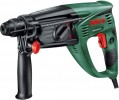Power consumption
Rated power consumed by the rotary hammer during operation. Usually, the maximum power consumption in normal operation is taken as the nominal power.
In general, the higher this indicator, the heavier and more performant the rotary hammer is, the more advanced its performance usually turns out to be. On the other hand, the electricity consumption of such tools is high. In addition, note that with the same power consumption, the actual set of individual characteristics for different tools may be different. For example, frequency and impact energy are inversely related, and for the same power input, higher frequency usually means less individual impact energy. So, according to this parameter, it is worth evaluating only the overall level of the instrument; for accurate selection for specific tasks, you need to pay attention to more specific characteristics.
Also note that power consumption data can be useful for some tasks related to catering — for example, if a construction site is powered by an autonomous generator and you need to estimate the load on this energy source.
Impact energy
The energy transmitted by the perforator to the material being processed upon impact; the higher this indicator, the stronger and more powerful each individual blow.
First of all, we recall that the energy of impacts is directly related to their frequency: an increase in frequency leads to a decrease in energy. Therefore, for models where the number of strokes can be adjusted, this paragraph usually gives the maximum energy achieved at the minimum speed of operation.
In general, higher impact energy improves efficiency when working with hard, stubborn materials, but requires more motor power (especially if it has to be combined with a high frequency). Therefore, it is worth choosing according to this parameter, taking into account specific tasks. So, for occasional use in everyday life, an energy of 2 J or less is enough, for home repair work of medium intensity, at least 3 J is desirable; a power of
4 J or more is already considered high; and in some industrial-grade perforators, this figure can reach 30 J.
Chuck type
The type of cartridge used in a rotary hammer to hold a working tool.
—
SD+. Abbreviation for it. "Steck-Dreh-Sitzt" — "insert-turn-fixed." Today's most common rotary hammer chuck, used in low and medium power models. It has a 10mm diameter shank with 4 slots and accepts tools from 4 to 26mm in diameter and 110mm to 1000mm in length. The advantages of SDS + are the reliability of fastening and convenience when changing tools — it does not require additional devices such as keys. The main drawback is the significant beating of the tool during rotation, due to which such a cartridge is very poorly suitable for drilling.
—
SDS Max. Modification of the SDS + cartridge (see above), intended for use in powerful professional models. It has a shank diameter of 18 mm and allows the use of tools with a diameter of up to 55 mm; otherwise similar to SDS+.
—
SDS-Quick. A variation of the SDS cartridge (see above), in the shank under which protrusions are used instead of grooves. It is also possible to install tools with 1/4" hex shanks in such a chuck. The most common tool diameter for SDS-Quick is 4-10 mm. This chuck is used relatively rarely.
—
Quick release. Chuck for holding drills and other tools used in drilling holes. The design is similar to those used in electric drills — it has 3 cams, it is designed for a too
...l with a cylindrical shank without grooves, and hand force is enough to install / remove the tool. Such a cartridge is devoid of the main drawback of SDS — beats during rotation; this allows you to use the rotary hammer for drilling with good quality. On the other hand, it is much worse for chiselling than SDS. Therefore, keyless chucks are usually supplied as an accessory and are installed instead of the standard SDS chuck.
— Key. The presence of a special key cartridge in the delivery set of the rotary hammer, usually in addition to the standard SDS (see above). In terms of mounting design, this chuck is similar to the keyless chuck (see above) and is also designed for use in drilling. Its main difference lies in the method of installing / removing the tool: you can’t do this with your bare hands, you must use a special key to compress / unclench the cams. Such a system is somewhat more reliable than a quick-clamping system, but much less convenient: changing a tool takes a lot of time, and the key can be lost.
